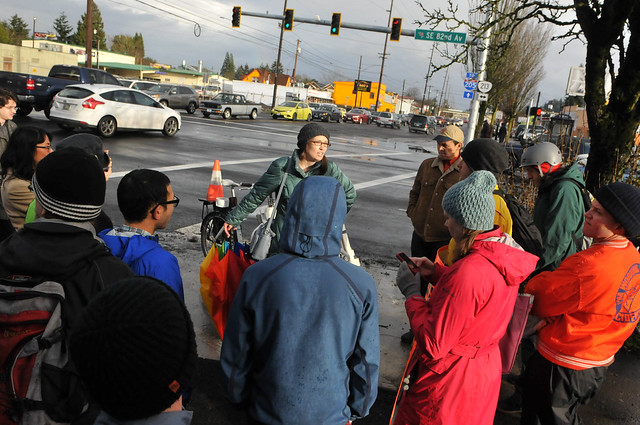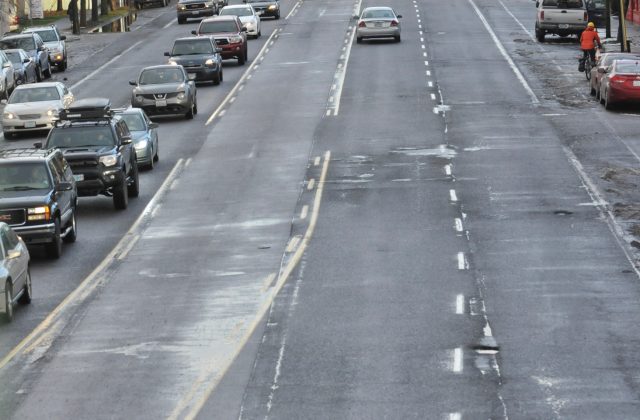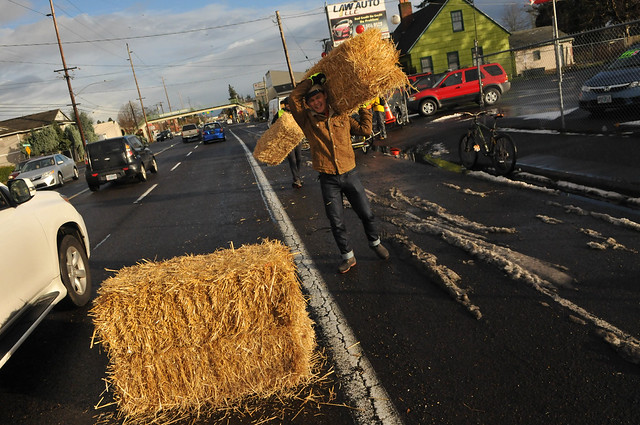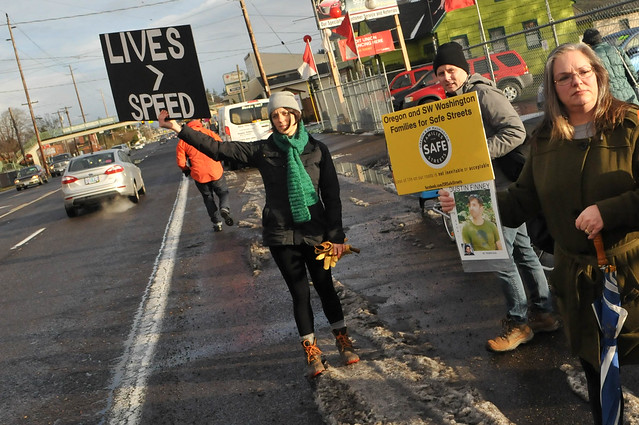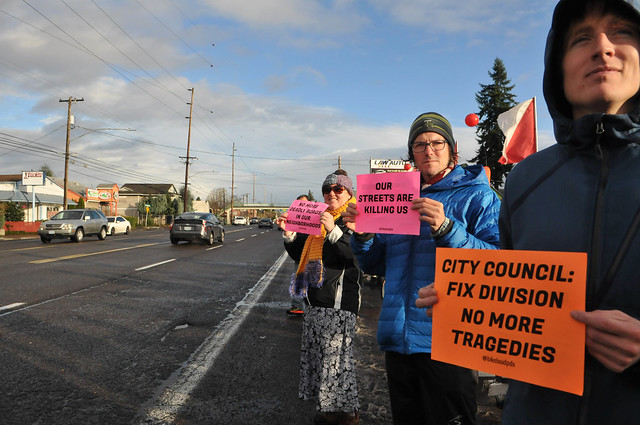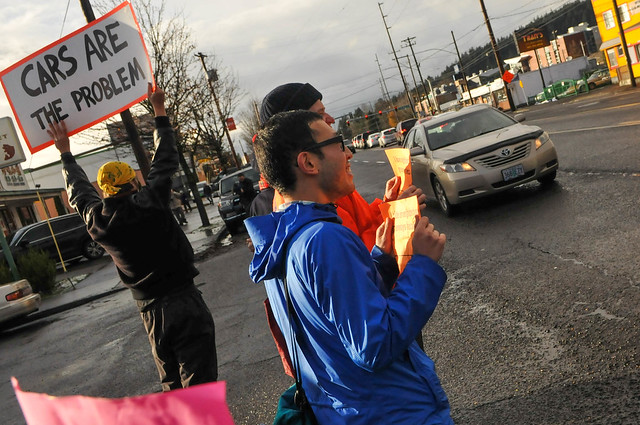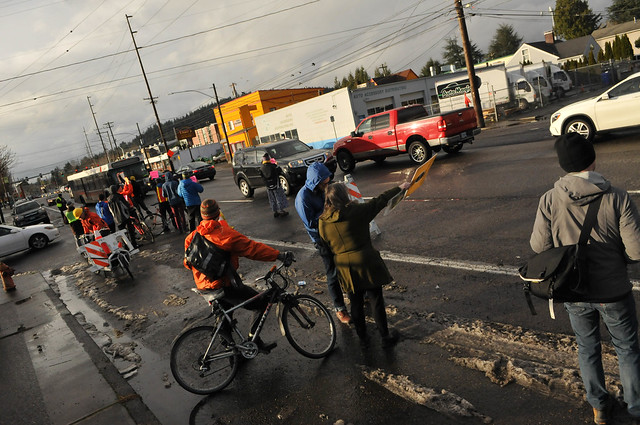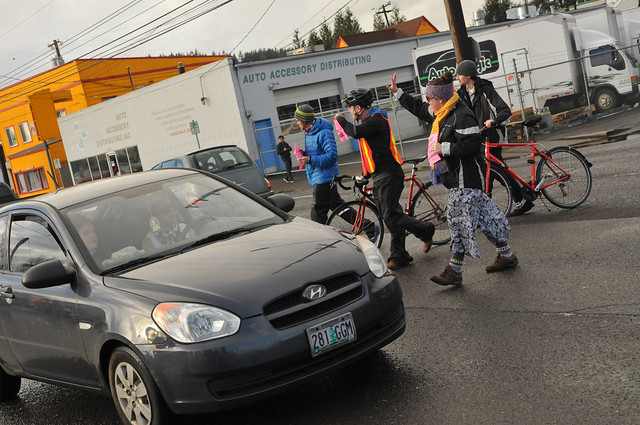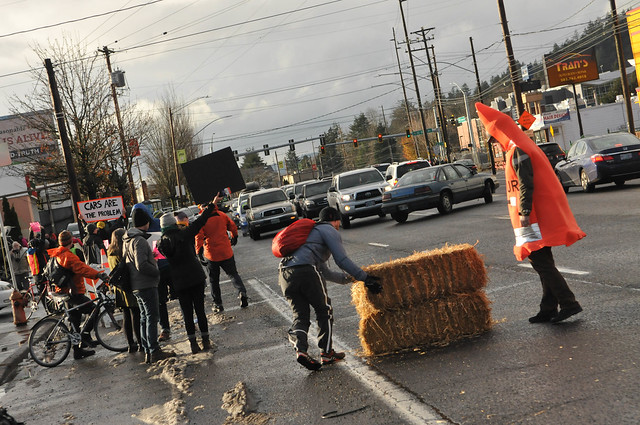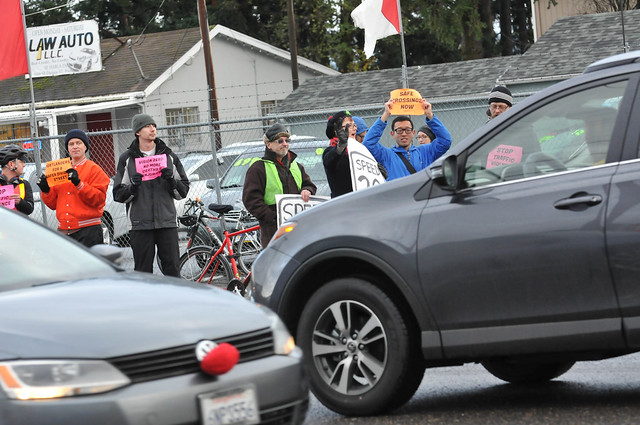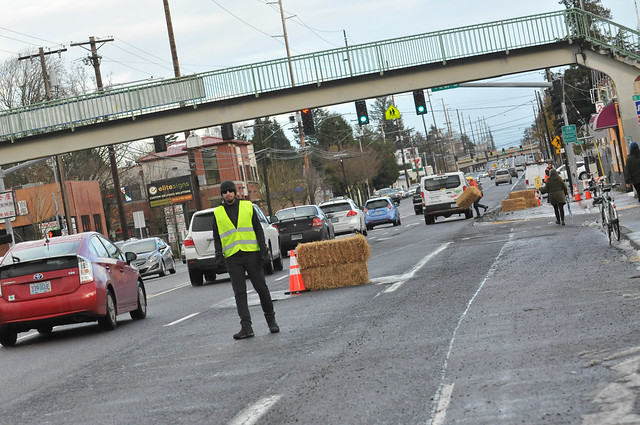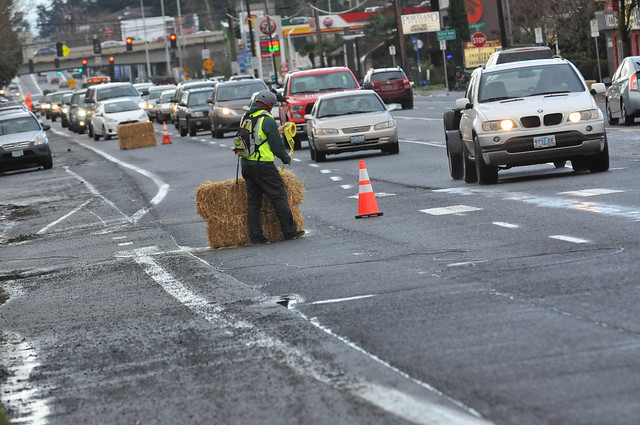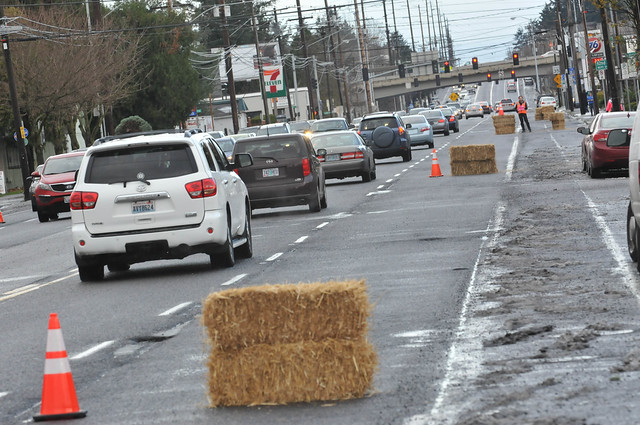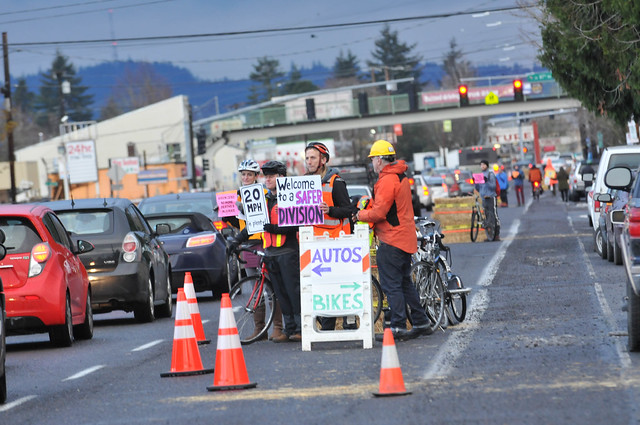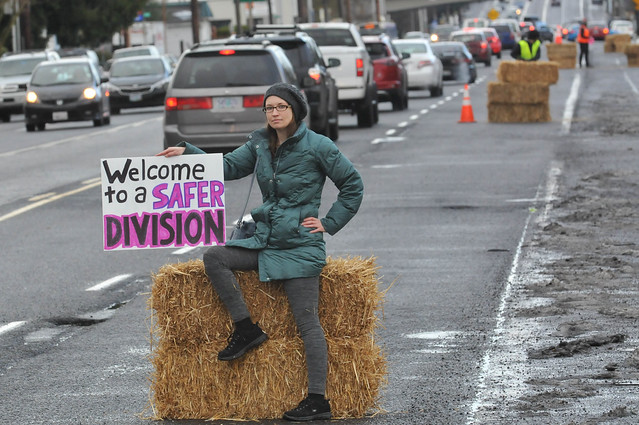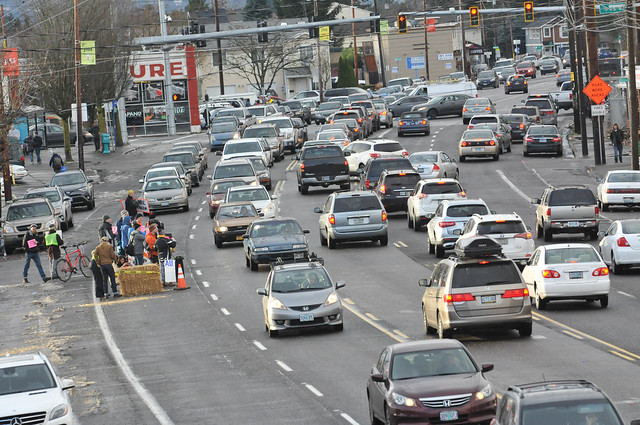
(Photos: J. Maus/BikePortland)
Division Street east of 82nd is one of the deadliest part of our entire transportation network. Designed exclusively around the use of private motorized vehicles, it’s a vast, nine-lane behemoth full of speeding, multi-ton vehicles driven by many people without regard to laws or the safety of others. It also happens to be directly adjacent to places where a growing number of Portlanders live, work and play.
“We’re here today because this street design doesn’t work.”
— Jessica Engelman, Bike Loud PDX
But for a few hours on Saturday afternoon everything was different. People drove slowly and there was space to talk and walk and ride a bike without worry of being run over.
After two more people were killed on Wednesday night, volunteer activists with Bike Loud PDX organized a “public takeover” of the street. A few dozen people braved the weather in an effort to narrow the street and slow people down — their bodies buttressed against Division’s traffic by fellow volunteers, hay bales, yellow caution tape and a few traffic cones.
Jessica Engelman led the event. “We’re here today,” she shared as everyone who gathered around her in a circle on the southwest corner of SE 82nd and Division, “Because this street design doesn’t work.” Engelman said she’s tired of hearing about personal responsibility of road users and wants the Portland Bureau of Transportation to reconfigure the lanes on the street. Engelman and other activists want the outer lanes of Division repurposed for something safer and more efficient like dedicated bus service and a bike lane. PBOT has already done some redesign of Division west of 82nd (adding a bike lane between 82nd and 60th) and Engelman demanded of the city that, “What you do over there [pointing west], you need to do here. It’s an equity issue.”
About half of all of Portland’s traffic fatalities happen east of Portland where wide streets encourage dangerous behaviors and options like biking and walking are far less attractive due to a lack of safe infrastructure. Division is a particularly glaring example. This year alone five people have died in traffic crashes while using Division (four people walking and one person driving). In addition to those fatalities there have been at least three serious injury crashes. Seven of these collisions happened on a two-mile stretch between 124th and 156th.
These reported collisions are in addition to the hundreds of daily aggressions suffered by everyone who uses the street.
Kristi Finney has seen more than her share of tragedy on Division. In August 2011 her son Dustin was biking near 87th when reckless drunk driver struck and killed him. Finney addressed the crowd yesterday while standing just a few blocks from where his body came to rest, “Thank you for being here to make this street safer when the people who are supposed to be doing it are not,” she said.
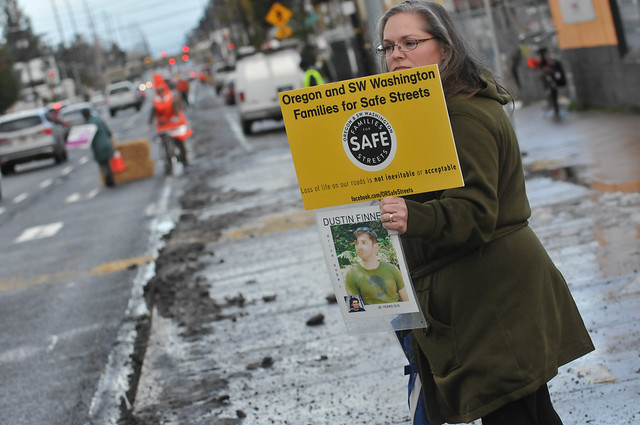
Then, looking out into the sea of people driving cars behind her, Finney added, “I wish they understood you are here to save their lives too.”
Since her son was killed Finney has devoted her life to safe streets. She’s a founding member of Oregon and SW Washington Families for Safe Streets (Facebook) and was one of nine bereaved family members to sign a letter this week demanding immediate action on Division from the City of Portland.
Advertisement
Local resident Ken Eucker heard about the event online and showed up to offer his support. “Every time there’s a death I’m quite affected by it,” he shared with me. “I’m hoping this event builds more awareness.” Eucker was wearing one of the rubber wrist bands with the words “Rest in Power” on it that were given out by Fallon Smart’s family after the 16-year-old was run down by a man driving 60 mph on SE Hawthorne last fall. “I feel like like if I don’t keep coming out this [feeling of concern] will fade like the ink on my wristband.”
After brief instructions from Engelman, people split into groups. Some were assigned hay bale duty, others volunteered to be on “PR duty” which meant they held signs and smiled-and-waved at passing traffic.
No one was quite sure how this relatively small group would tame traffic on such a busy arterial. They got a little reassurance by the presence of a Portland Police Bureau vehicle that was clearly circling the intersection (turns out Engelman notified PBOT and the PPB prior to the event and the patrol car was sent to make sure everyone stayed safe).
The group set up the first station at 84th. While a dozen or so people held signs saying things like “20 is plenty” and “No more deaths on Division,” others hauled large bales of hay from a van. The bales were stacked two-high in the outer standard vehicle lane (to the left of the bike lane and parking lane). The idea was to have the hay bales act as traffic calming and a barrier so that people in cars would merge into one lane. They were placed every block or so on both sides of the street between 84th and 90th. To prevent people from plowing through the hay bales with their cars, volunteers stood in front of them holding signs while smiling and waving.
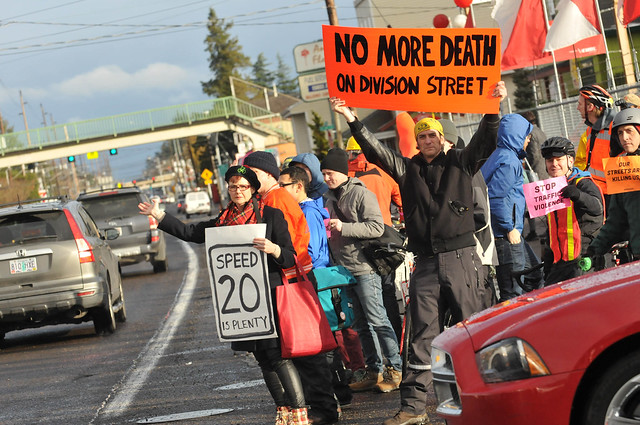
It worked.
Almost immediately people merged their cars and trucks into one lane of traffic and slowed way down. The other lanes opened up for people walking and biking (the existing bike lane was not safe to ride in due to slush and ice).
We’re taught to be afraid of cars, especially on big nasty streets like Division. Engineers are afraid to slow them down or reduce their capacity, vulnerable road users try to avoid them at all costs. But we learned on Saturday that managing this public menace can be as easy as herding sheep. With just a few hay bales and homemade signs, people fell dutifully into line. There were a few people who yelled and/or tried to speed around the bales, but overall everyone seemed fine with the new arrangement.
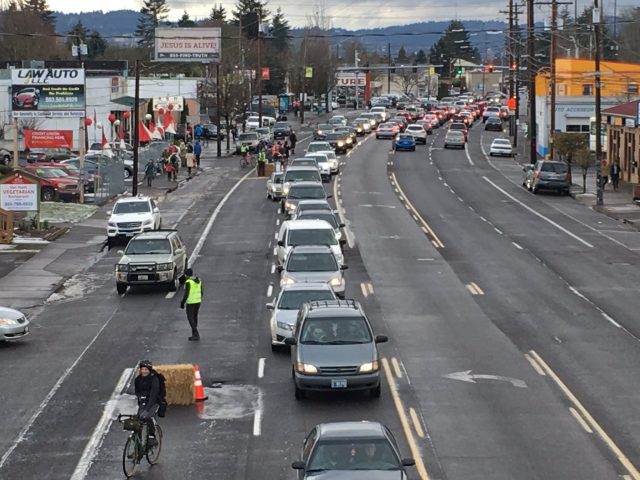
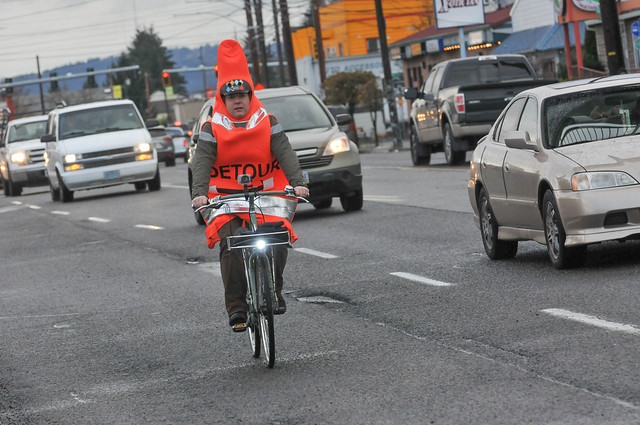
In an interview after the event, Engelman said she planned to keep the bales on the street indefinitely. “We will take them down if we have assurance from PBOT that this street will be addressed.” She said the event wasn’t a one-off demonstration but rather, “An emergency traffic-calming measure not just for a few hours but until the problem goes away.”
It was reported on Twitter last night that the City of Portland already removed the bales.
It’s not likely the activists will go away as easily.
“PBOT has our backs to the wall and we want them to know we’re serious,” Engelman said. “This isn’t the type of action that Bike Loud typically does, but this is not a typical situation.”
Further reading: Twitter threads by two people who were at the event: @_P_J and @twjpdx23; coverage by The Oregonian.
— Jonathan Maus, (503) 706-8804 – jonathan@bikeportland.org
BikePortland is supported by the community (that means you!). Please become a subscriber or make a donation today.


